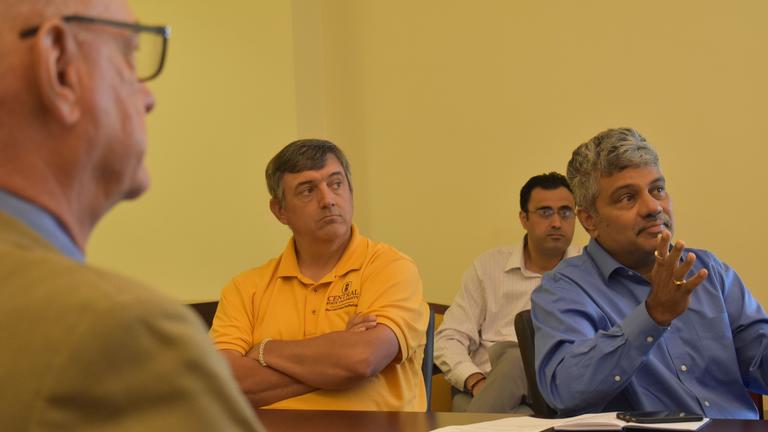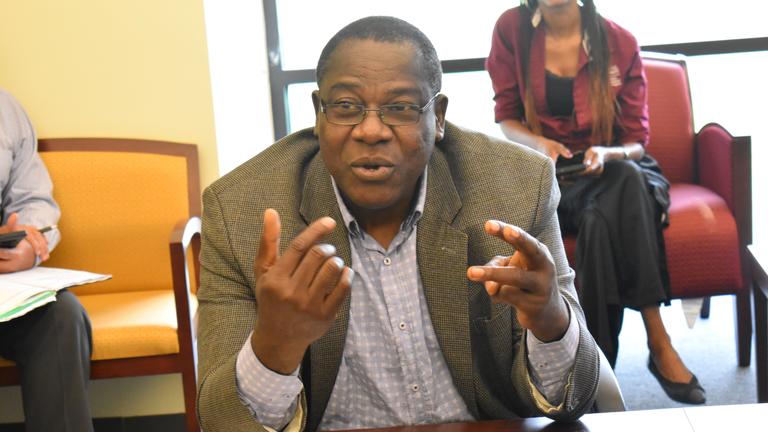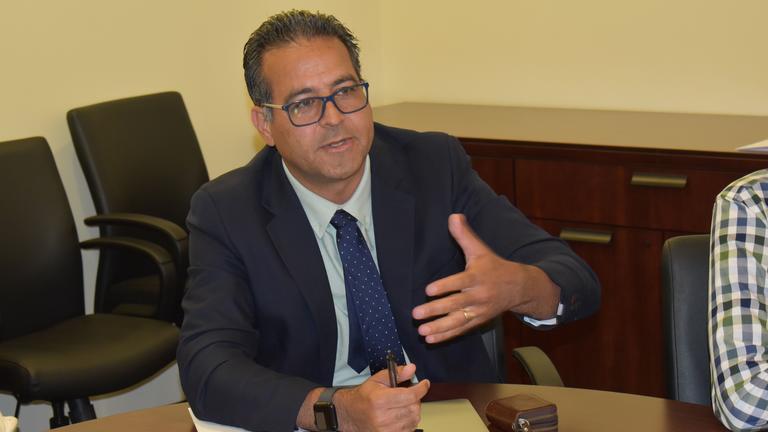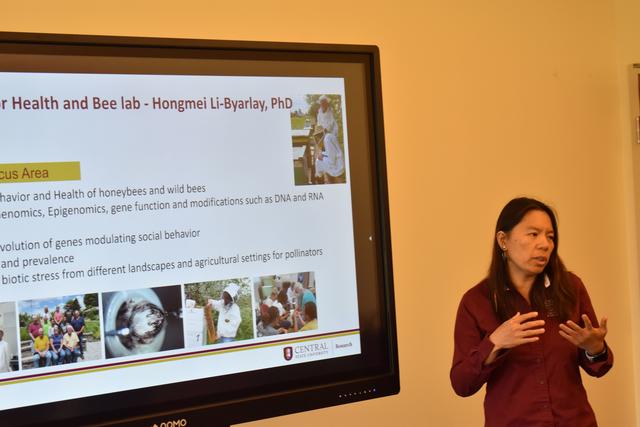
Researchers proudly showcase work, appeal for state funds to build University's research infrastructure
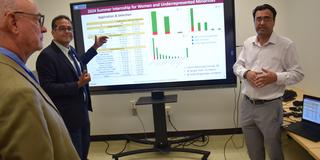
Central State University’s teaching and research professors from the John W. Garland College of Engineering, Science, Technology, and Agriculture and the 1890 Land-Grant Programs gained the ears and eyes of Ret. Col. Joseph E. Zeis Jr., senior adviser to Ohio Gov. Mike DeWine on aerospace and defense who spent half a day on campus on July 9.
Zeis spent two hours listening to professors' slide presentations on diverse agricultural and scientific research projects. Following that, he toured nearly a dozen labs where professors showcased solution-driven research projects that secured competitive state and federal funding.
Research areas span food, agriculture, transportation, semiconductor processing, unmanned aerial systems, water quality, soil health, nutrigenomics, and polymer materials.
“The depth and breadth of your research is very impressive,” Zeis said between two labs during his tour.
Chris Widener, senior policy consultant in the Office of the President at Central State, facilitated Zeis’ visit and meetings with University faculty.
“Central State University invited Mr. Zeis to visit the campus and meet with the University’s researchers,” Widener said. “The purpose of the meeting was to introduce Mr. Zeis to the diverse expertise of the faculty and the laboratory equipment. The goal was to facilitate connections with state and federal agencies that are either conducting similar research or needing research in related areas."
Pollinator research on honeybees
In her presentation, Dr. Hongmei Li-Byarlay, associate professor of Entomology, said her Central State research focuses on improving pollinator health, particularly honeybees, across Ohio for greater fruit and vegetable yields. She noted that annually nationwide, about 50% of bee colonies are lost with Ohio's loss being higher, necessitating research like hers that educates and supports beekeepers to provide safer abodes for pollinator honeybees.

“Bees pretty much pollinate all the fruits and vegetables for human consumption,” Li-Byarlay said. “If you think about it, every three spoons of food, one spoon of those is pollinated by the bees and (other) pollinators.”
Central State professors welcomed the rare opportunity to spend half a day with a cabinet-level adviser to DeWine to present and showcase to him the diversity and scope of their research at their University.
“His (Zeis’) visit is very useful for us,” said Dr. Krishna Kumar Nedunuri, professor of Environmental Engineering whose presentation was on water quality, circulation and distribution. “Importantly, he has so many professional contacts in the state of Ohio in the areas that we are working. He was able to provide them for us. He seems assiduously interested in seeking opportunities for the scientists.”
Dr. Pratibha Gupta, research associate professor of food and nutrition and health, added Zeis “was deeply interested in our research work and willing to give support by connecting us with other organizations.”
Zeis said a major purpose of his visits around Ohio is to encourage and foster “collaboration and partnership” among researchers from different universities, “a unique opportunity to link major institutions to the advantage of all.”
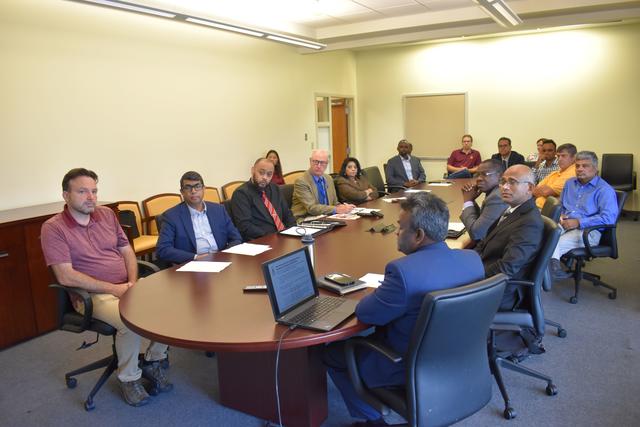
Zeis’ visit to CSU was an opportunity “to demonstrate our faculty members’ research-focused areas and their capabilities,” said Dr. Shafiqur Rahman, professor and associate research director for 1890 Land-Grant Programs.
“The more they (advisers like Zeis) know about our research potential and capabilities, the more they will be able to communicate to the government that CSU has the right expertise and resources to undertake cutting-edge research.”
What next?
Nedunuri expressed hope that, after visiting Central State and witnessing it first hand, Zeis would relay the message to DeWine and state legislators. This, he emphasized, could aid in bolstering Central State as a research Institution, especially considering its relatively recent 1890 Land-Grant designation, which is only a decade old.
“We need the state to increase our resources to build our research infrastructure,” Nedunuri said.
“(The) 1890 Land-Grant universities don’t get substantial funds for infrastructure from (the United States Department of Agriculture's) National Institute of Food and Agriculture. We need funds from the state of Ohio for purchase of lab equipment and hiring of personnel.”
Stronger networking and collaboration between the University and other institutions could result from Zeis’s visit, according to Rahman.
“During the tour, Mr. Zeis mentioned that some other agencies need to see our facilities (at Central State) and learn about our research capabilities,” Rahman said. “A productive follow-up to the visit would be to keep in touch with Mr. Zeis to bring those agencies and decision makers to campus, explain our needs, and connect with the right people for future collaboration.”
Q&A: Governor's senior adviser visits Central State University
Retired Col. Joseph E. Zeis Jr. serves as a senior adviser for Aerospace and Defense, a cabinet-level position in Ohio Gov. Mike DeWine’s administration. Zeis was appointed in February 2019 to focus on Ohio’s military and aerospace installations.
Zeis is a retired U.S. Air Force colonel with more than 26 years of service. He graduated from the U.S. Air Force Academy in 1981 and holds master’s degrees in Aeronautical Engineering from the Air Force Institute of Technology and in National Resource Strategy from the Industrial College of the Armed Forces.
Following Zeis’ visit to Central State University on July 9, he responded to a list of questions from Cyril Ibe, interim Land-Grant communications coordinator, via email. His responses have been edited lightly for brevity and clarity.
Q: What aspects of the CSU researchers' presentations and lab tours impressed you the most?
A: I was very impressed with the breadth and depth of the research performed at Central State University.
The varied subjects demonstrated the broad research potential of CSU, and both the teaching and research faculty interest areas are highly impactful to Ohio and the United States.
Q: What were your key takeaways from the visit?
A: The application to emerging aerospace and defense usage goes far beyond the immediately obvious. There are multiple impactful research areas that are useful to key Ohio aerospace initiatives, including the intersection of food and agriculture and sustainable space systems; the adaptation of drone technologies to improved farming techniques; the development of remote sensing to algae plume characterization, to name just a few. Education to lead Ohio and our nation in these technologies is crucial to Ohio maintaining the leading edge in aerospace and defense.
Q: If you have the governor's ear after your visit, what are you going to tell him about what you saw and heard at Central State University?
A: There is a lot going on at this University that impacts Ohio’s defense infrastructure and our aerospace industries. It is impressive.
Q: Does the governor see Central State in a position to fulfill specific research needs for the state of Ohio?
A: Again, the key to applicable research, either here in Ohio or nationally, is in alignment with our federal and industrial partners in aerospace and defense. NASA and the Air Force Research Laboratory are crucial nodes in this network. Remote sensing, human performance, microelectronics, and drone systems are fundamental to advanced systems.
Q: Why did you refer CSU researchers to a number of networking contacts and urge them to follow up after your visit?
A: I find in my travels all over Ohio that the key is collaboration and partnership.
Connecting Ohio’s massive aerospace and defense industrial and educational/research partners provides a powerful synergy to lead this nation. This is a unique opportunity to link major institutions to the advantage of all.
Q: What is your overall message to the CSU research professors at the end of your visit?
A: Thank you for what you do everyday. You are focused on educating the youth of Ohio to be prepared for a technological future. My interactions with those post-doctorate assistants and undergraduate research students point to the next generation of applied technologists and researchers who will lead this nation into the 21st century. They were impressive. This STEM pipeline is crucial.
